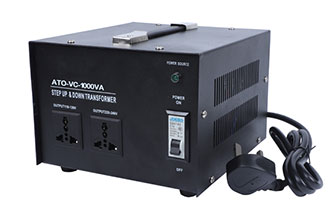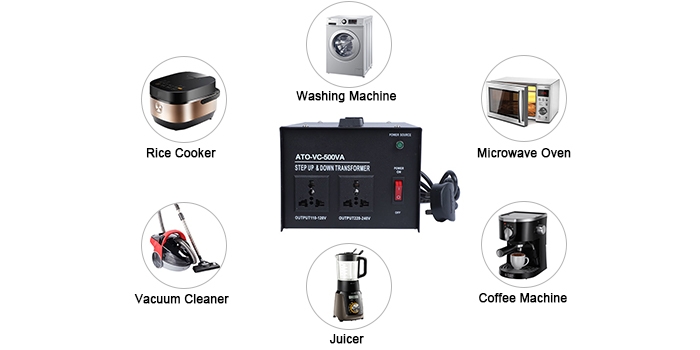In today's globalized world, with international travel, work, and study becoming the norm, differences in power standards have become an issue that can't be ignored. Various countries and regions adopt different voltage standards, primarily centered around 110V and 220V systems, which presents challenges when using foreign electrical devices. Voltage converters, compact yet essential devices, act as a bridge between these different voltage standards. Inverter Online Shop aims to explore the principles, types, usage tips, and maintenance of voltage converters, offering readers comprehensive and professional guidance.
What is a Voltage Converter?
Definition and Function: A voltage converter, also known as a home transformer or power converter, is an electrical device designed to adjust voltage. Its main function is to convert between different voltage standards, ensuring electrical devices operate smoothly in diverse power environments. A voltage converter is an indispensable companion for individuals traveling or working abroad, enabling the safe and stable operation of devices like hair dryers, rice cookers, and laptops across different voltage standards.
Its main function is to convert between different voltage standards, ensuring electrical devices operate smoothly in diverse power environments. A voltage converter is an indispensable companion for individuals traveling or working abroad, enabling the safe and stable operation of devices like hair dryers, rice cookers, and laptops across different voltage standards.
Working Principle: Voltage converters operate based on electromagnetic induction. When the input voltage (e.g., 220V) passes through the converter’s primary coil, an induced electromotive force is generated in the secondary coil. The size of this force depends on the input voltage and the ratio of coil turns (known as the transformation ratio). Adjusting this ratio provides the desired output voltage (e.g., 110V). Conversely, for converters that step up from 110V to 220V, the working principle remains the same, with changes in current direction and voltage amplitude.
Types and Selection of Voltage Converters
- Types of Voltage Converters
Voltage converters can be classified into two main categories based on the direction of conversion:
1. 220V to 110V Converters: These are used to convert the common 220V power supply into 110V, suitable for devices from regions such as North America and Japan.
2. 110V to 220V Converters: These are designed to step up 110V power to 220V, ideal for using appliances from low-voltage countries in high-voltage environments.
- Selection Criteria
1. Power Matching: The first consideration when choosing a voltage converter is whether its power capacity meets the needs of your device. Typically, the rated power of the converter should exceed the rated power of the device by at least 10%-20% to ensure stable operation and prolong its lifespan.
2. Brand and Quality: Opt for reputable brands and certified products, as these generally offer better safety and reliability.
3. Additional Features: High-end converters may offer extra safety features like overload and short-circuit protection, as well as advanced functions like intelligent regulation and voltage stabilization. Choose according to your specific needs.
Usage Tips and Precautions for Voltage Converters
- Preparation Before Use
1. Confirm Voltage Requirements: Before using a voltage converter, confirm the rated voltage of your device to ensure compatibility.
2. Check Plugs and Sockets: Make sure the converter’s plug is compatible with the power outlets in your destination country to avoid relying on adapters, which can compromise safety.
- Precautions During Use
1. Adequate Capacity: As mentioned, ensure the converter’s power capacity is sufficient to handle any potential surges in power demand during device startup and operation.
2. Preheating and Heat Dissipation: After long periods of inactivity or first-time use, it's recommended to preheat the converter for a few minutes to stabilize internal components. Monitor heat dissipation during use to avoid overheating from prolonged high-load operation.
3. Regular Inspections: Periodically check the converter’s cords and plugs for signs of wear or damage, and replace them if necessary.
4. Electrical Safety: Avoid using voltage converters in humid, high-temperature, or flammable environments to prevent electrical shock or fire hazards.
5. Proper Shutdown: After use, follow the manufacturer’s instructions for shutting down the converter and disconnect it from the power source to prevent unnecessary energy consumption and safety risks.
- Handling Special Situations
1. Multiple Device Connections: If you need to connect multiple devices to the converter, ensure their combined power does not exceed the converter’s rated capacity. Spread out usage if possible to avoid overloading.
2. International Travel: The 3000W voltage converter for sale on our website is designed for travelers with dual voltage input AC 110/220V with two output universal sockets. For frequent international travelers, it is advisable to invest in a universal voltage converter with multiple plug types and a wide voltage range to suit different countries and regions.

Maintenance and Care of Voltage Converters
- Routine Maintenance
1. Cleaning and Care: Regularly wipe the converter's exterior with a dry cloth to keep it clean and dry. Avoid using damp cloths or chemical cleaners, as these may damage the surface or internal components.
2. Storage: When not in use for extended periods, store the converter in a dry, ventilated area away from heat sources to prevent damage from sunlight or humidity.
- Troubleshooting
1. Identifying Abnormalities: If the converter emits strange noises, becomes unusually hot, or outputs unstable voltage, stop using it immediately and investigate the cause.
2. Professional Repairs: For issues beyond general troubleshooting, contact a professional technician for repairs or replacement. Do not attempt to disassemble or repair the converter yourself, as this may cause further damage or safety hazards.
Voltage converters are essential small appliances in modern life, especially for those frequently crossing borders. We Inverter.com has provided a thorough overview of voltage converter principles, types, usage tips, and maintenance. Armed with this knowledge, readers can confidently choose and use the appropriate voltage converter to ensure convenience and safety in their travels or work abroad.
